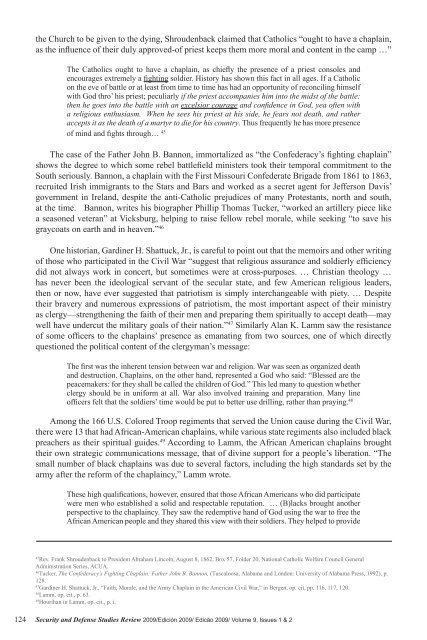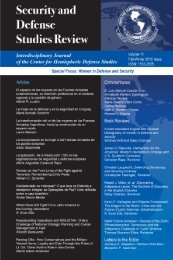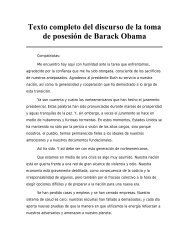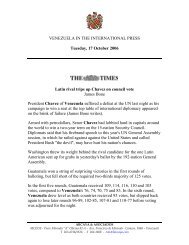the Church to be given to the dying, Shroudenback claimed that Catholics “ought to have a chaplain,as the influence of their duly approved-of priest keeps them more moral <strong>and</strong> content in the camp …”The Catholics ought to have a chaplain, as chiefly the presence of a priest consoles <strong>and</strong>encourages extremely a fighting soldier. History has shown this fact in all ages. If a Catholicon the eve of battle or at least from time to time has had an opportunity of reconciling himselfwith God thro’ his priest; peculiarly if the priest accompanies him into the midst of the battle:then he goes into the battle with an excelsior courage <strong>and</strong> confidence in God, yea often witha religious enthusiasm. When he sees his priest at his side, he fears not death, <strong>and</strong> ratheraccepts it as the death of a martyr to die for his country. Thus frequently he has more presenceof mind <strong>and</strong> fights through… 45The case of the Father John B. Bannon, immortalized as “the Confederacy’s fighting chaplain”shows the degree to which some rebel battlefield ministers took their temporal commitment to theSouth seriously. Bannon, a chaplain with the First Missouri Confederate Brigade from 1861 to 1863,recruited Irish immigrants to the Stars <strong>and</strong> Bars <strong>and</strong> worked as a secret agent for Jefferson Davis’government in Irel<strong>and</strong>, despite the anti-Catholic prejudices of many Protestants, north <strong>and</strong> south,at the time. Bannon, writes his biographer Phillip Thomas Tucker, “worked an artillery piece likea seasoned veteran” at Vicksburg, helping to raise fellow rebel morale, while seeking “to save hisgraycoats on earth <strong>and</strong> in heaven.” 46One historian, Gardiner H. Shattuck, Jr., is careful to point out that the memoirs <strong>and</strong> other writingof those who participated in the Civil War “suggest that religious assurance <strong>and</strong> soldierly efficiencydid not always work in concert, but sometimes were at cross-purposes. … Christian theology …has never been the ideological servant of the secular state, <strong>and</strong> few American religious leaders,then or now, have ever suggested that patriotism is simply interchangeable with piety. … Despitetheir bravery <strong>and</strong> numerous expressions of patriotism, the most important aspect of their ministryas clergy—strengthening the faith of their men <strong>and</strong> preparing them spiritually to accept death—maywell have undercut the military goals of their nation.” 47 Similarly Alan K. Lamm saw the resistanceof some officers to the chaplains’ presence as emanating from two sources, one of which directlyquestioned the political content of the clergyman’s message:The first was the inherent tension between war <strong>and</strong> religion. War was seen as organized death<strong>and</strong> destruction. Chaplains, on the other h<strong>and</strong>, represented a God who said: “Blessed are thepeacemakers: for they shall be called the children of God.” This led many to question whetherclergy should be in uniform at all. War also involved training <strong>and</strong> preparation. Many lineofficers felt that the soldiers’ time would be put to better use drilling, rather than praying. 48Among the 166 U.S. Colored Troop regiments that served the Union cause during the Civil War,there were 13 that had African-American chaplains, while various state regiments also included blackpreachers as their spiritual guides. 49 According to Lamm, the African American chaplains broughttheir own strategic communications message, that of divine support for a people’s liberation. “Thesmall number of black chaplains was due to several factors, including the high st<strong>and</strong>ards set by thearmy after the reform of the chaplaincy,” Lamm wrote.These high qualifications, however, ensured that those African Americans who did participatewere men who established a solid <strong>and</strong> respectable reputation. … (B)lacks brought anotherperspective to the chaplaincy. They saw the redemptive h<strong>and</strong> of God using the war to free theAfrican American people <strong>and</strong> they shared this view with their soldiers. They helped to provide45Rev. Frank Shroudenback to President Abraham Lincoln, August 8, 1862, Box 57, Folder 20, National Catholic Welfare Council GeneralAdministration Series, ACUA.46Tucker, The Confederacy’s Fighting Chaplain: Father John B. Bannon, (Tuscaloosa, Alabama <strong>and</strong> London: University of Alabama Press, 1992), p.128.47Gardiner H. Shattuck, Jr., “Faith, Morale, <strong>and</strong> the Army Chaplain in the American Civil War,” in Bergen, op. cit, pp. 116, 117, 120.48Lamm, op. cit., p. 63.49Hourihan in Lamm, op. cit., p. i.124<strong>Security</strong> <strong>and</strong> <strong>Defense</strong> <strong>Studies</strong> <strong>Review</strong> 2009/Edición 2009/ Edicão 2009/ Volume 9, Issues 1 & 2
a basic education for the troops, which enabled the men to have a better chance for successafter their service to the army had ended. They fought racism in the form of segregatedofficers’ dining hall, <strong>and</strong> unequal pay for themselves <strong>and</strong> for their troops. African Americanchaplains were an important factor in raising morale <strong>and</strong> hence combat effectiveness. 50Onward Catholic Soldiers: The Chaplainry, the U.S. military <strong>and</strong> the Catholic Church duringthe World WarsMy slogan to the chaplains with the troops is ‘Keep them praying.’ In many places chaplainsgather together a group of soldiers between attacks <strong>and</strong> kneel with them in prayer. A rosaryaround one’s neck for occasional fingering <strong>and</strong> a rifle in h<strong>and</strong> is a combination of power thatneither Jap nor Devil can resist.-- Chief of ChaplainsWilliam Arnold, 1942 51The relationship of the U.S. Catholic Church <strong>and</strong> its military chaplains during the course of the twoworld wars offers an interesting point of comparison as the chaplains were members of a religionthat began the period as an out-group, but by mid-century had achieved a firm place in the Americanestablishment. During this entire period, Catholic chaplains reflected the patriotism, sense of duty<strong>and</strong> heroism that made them important strategic communicators in times of war <strong>and</strong> in times of peace.At the beginning of World War I, the Catholic Church in America was viewed by suspicionby the Protestant establishment, including the occupant of 1600 Pennsylvania Avenue, WoodrowWilson, <strong>and</strong> his State Department. As Church historian Peter D. Agostino noted, “liberal paranoia”about a “subversive Catholic monolith loyal to papal Rome” was tied to a presumption in the liberalpress <strong>and</strong> by Allied statesmen that the Holy See favored the Central Powers, which led them to fear“the disruptive potential of the American Catholic population.” In fact, although Pope Benedictallowed Catholic priests to serve as chaplains in the military of the liberal Italian republic, it is alsotrue that the Holy See was willing to let “governments preoccupied with their internal unity”—i.e., the United States—believe that Rome had such subterranean control, if the suspicion wouldultimately favor the Holy See’s own negotiations with the Italian state to resolve the Roman Questionon Catholic terms. As a result, “accusations against the Church <strong>and</strong> defensive Catholic responsesstrengthened boundaries separating Catholics from other Americans.” In an interesting juxtapositionto the politically-supportive role the U.S. government supposed Catholic <strong>and</strong> other denominations’chaplains were to play in the Great War, “(t)he liberal ideology embodied in the international nationstatesystem had no place for the Church, a strange international institution that Wilson, good liberalthat he was, insisted ought to attend to purely spiritual affairs.” 52The U.S. entry into the war led the American Catholic episcopacy to offer a ringing endorsementof Wilson’s action. “The bishops reminded their people that obedience to civil authorities was aduty, <strong>and</strong> the National Catholic War Conference, created to mobilize Catholics, became an effectiveorganization in the U.S. war effort,” D’Agostino noted. “American Catholic nationalism grew inresponse to the insecurity Catholics felt as their fellow citizens attacked the Holy See <strong>and</strong> questionedCatholic loyalty.” 53 The National Catholic War Council, forerunner of the National Catholic WarConference (known today as the National Conference of Catholic Bishops), was placed under thecontrol of the fourteen American archbishops. Its mission “was to cooperate with other denominationalgroups under the general supervision of the government to coordinate Catholic activities ranging50Lamm, op. cit., p. 85.51February 21, 1942 letter to Rev. Thomas F. McBride, St. Michael’s Rectory, Troy, New York, Box 57, Folder: “Military Affairs: Chaplains, 1942-1945,” National Catholic Welfare Council General Administration Series, ACUA.52D’Agostino, Transnational Catholic Ideology from the Risorgimento to Facism,” (Chapel Hill: University of North Carolina Press, 2004), p. 104-105, 111-112, 116.53D’Agostino, op. cit., p. 115.54Gerald P. Fogarty, The Vatican <strong>and</strong> the American Hierarchy from 1870 to 1965 (Stuttgart: Anton Hiersemann, 1982), p. 214.<strong>Security</strong> <strong>and</strong> <strong>Defense</strong> <strong>Studies</strong> <strong>Review</strong> 2009/Edición 2009/ Edicão 2009/ Volume 9, Issues 1 & 2 125
- Page 4 and 5:
Document: Speech on “Security, In
- Page 6 and 7:
6Security and Defense Studies Revie
- Page 8 and 9:
un tema de seguridad y defensa porq
- Page 10 and 11:
Los Intereses de la República Popu
- Page 12 and 13:
En el marco estratégico descrito e
- Page 14 and 15:
Works (FAW), Geeley, Dongfeng, y Ch
- Page 16 and 17:
interés en participar en el yacimi
- Page 18 and 19:
al emplear personas locales en todo
- Page 20 and 21:
había un banco en Colombia especia
- Page 22 and 23:
ehén de los FARC, escribe de siete
- Page 24 and 25:
estadounidenses en el futuro, y por
- Page 26 and 27:
26Security and Defense Studies Revi
- Page 28 and 29:
Existe numerosa literatura que trat
- Page 30 and 31:
La Tabla 1.1, demuestra que el apor
- Page 32:
Los cuestionamiento a este modelo d
- Page 35 and 36:
….derogaremos la Ley del Cobre y
- Page 37 and 38:
Figura 4.3.Aporte de CODELCO por ve
- Page 39:
Figura 6.Elaboración propia distri
- Page 42 and 43:
de los proyectos de defensa necesit
- Page 44 and 45:
En el caso de las inversiones en de
- Page 46 and 47:
Anexo 1PROTOCOLO DE ACUERDO QUE ACO
- Page 48 and 49:
OECD. “Models of Public Budgeting
- Page 50 and 51:
proyectos nacionales y democrático
- Page 52 and 53:
DesprofesionalizaciónEn la región
- Page 54 and 55:
Según algunos autores, “no sorpr
- Page 56 and 57:
(antinarcóticos), la Guardia Coste
- Page 58 and 59:
supervigilen las acciones intrusiva
- Page 60 and 61:
Quizás una de las fallas provenga
- Page 62 and 63:
Junto con ello se elaboró una nuev
- Page 64 and 65:
Colombia). Por otro, hay una serie
- Page 66 and 67:
Maldonado, Carlos, “Profesionalis
- Page 68 and 69:
policías y militares no ha estado
- Page 70:
La relación entre fuerzas militare
- Page 73 and 74: dictaduras. En aquellos con más tr
- Page 75 and 76: efectos de planificación se ha hab
- Page 77 and 78: BibliografíaAguila, Ernesto y Mald
- Page 79 and 80: Sherman, Lawrence. et.al. 1973. Tea
- Page 81: Influenza Pandemic and its National
- Page 84 and 85: and restaurant services” is expec
- Page 86 and 87: The ability of the health sector to
- Page 88 and 89: BibliographyAlmond, D. and B. Mazum
- Page 90 and 91: El trabajo parte del supuesto de qu
- Page 92 and 93: es tanto una elección voluntaria c
- Page 94 and 95: Por otro lado, Rusia nunca ha visto
- Page 96 and 97: La Organización del Tratado del At
- Page 98 and 99: liquidez internacional pero tambié
- Page 100 and 101: petróleo recientemente descubierta
- Page 102 and 103: Dentro de este esquema, Estados Uni
- Page 104 and 105: 104Security and Defense Studies Rev
- Page 106 and 107: minimize a number of attempts at fo
- Page 108 and 109: kidnapping, of Maria Edith de Deber
- Page 110 and 111: The political campaign that resulte
- Page 112 and 113: would carry out the more violent ta
- Page 114 and 115: of the EPP so far, is the relative
- Page 117 and 118: to accept ideas, policies or course
- Page 119 and 120: eing killed themselves—the idea t
- Page 122 and 123: In Latin America, the role played b
- Page 126 and 127: from providing military chaplains t
- Page 128 and 129: Perhaps one of the clearest example
- Page 130 and 131: was prepared by the Office of the C
- Page 132 and 133: 132Security and Defense Studies Rev
- Page 135 and 136: Keynote Speech by Dr. Frank O. Mora
- Page 137 and 138: If successful, these infrastructure
- Page 139 and 140: Security, Intelligence and the Role
- Page 141 and 142: Clearly, security, intelligence and
- Page 143 and 144: Contratapa(Contratapa offers, in a
- Page 145 and 146: efforts have become intertwined; fo
- Page 147 and 148: comprensión de sus valores y cultu
















